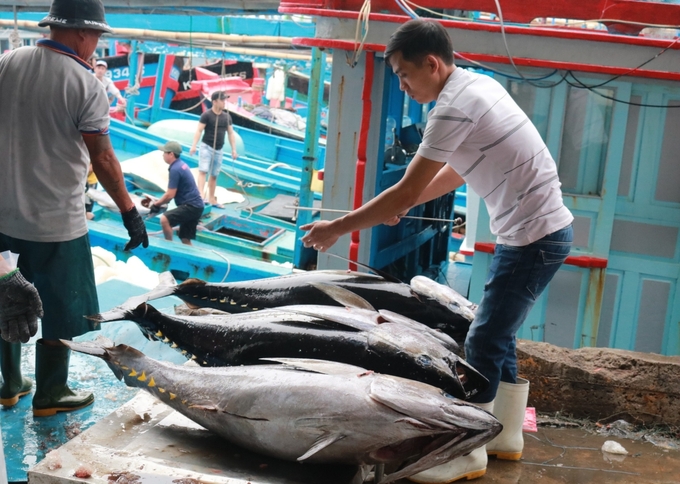December 7, 2025 | 03:53 GMT +7
December 7, 2025 | 03:53 GMT +7
Hotline: 0913.378.918
December 7, 2025 | 03:53 GMT +7
Hotline: 0913.378.918
The Vietnam Association of Seafood Exporters and Producers (VASEP) recently reported that Vietnam's seafood export activities exhibited numerous positive indicators in the first two months of 2025. The total export revenue exceeded USD1.42 billion, representing an 18.2% increase from the same period in 2024. In particular, February 2025 alone recorded USD655 million in export revenue, marking an impressive growth of 42.6%.
Shrimp remained the brightest highlight, contributing over USD542 million, up 30.8% compared to the same period in 2024. Assuming that the shrimp industry does not experience any additional disruptions due to unstable factors such as trade conflicts under the Trump administration, VASEP anticipates an optimistic outlook for 2025. Since October 2024, the average import price has been increasing and is anticipated to remain elevated in 2025 as a result of stable inventory levels, which will increase the confidence of both importers and exporters..
Meanwhile, pangasius exports reached over USD253 million, a small decline of 0.8% compared to the same period last year. The pangasius market is currently confronting several challenges. The rising cost of raw materials, driven by increasing input costs (such as feed and labor), and uncertainties related to U.S. tariff policies are putting pressure on the industry. The U.S. has imposed an additional 10% tariff on processed seafood from China, indirectly affecting global trade flows. Demand in the U.S. remains lackluster, while high inventory levels could limit price increases.

Vietnam's shrimp exports grew positively in the first two months of 2025, reaching more than 542 million USD. Photo: Hong Tham.
Pangasius farmers must exercise caution and refrain from spontaneous production expansion, as the current prices may be artificially high and could experience a significant decline if the supply exceeds the demand. In order to preserve competitive advantages, it will be essential to develop strategies that emphasize value-added products, adopt modern farming technologies, and fortify relationships with enterprises.
Tuna exports reached over USD126 million in the first two months of 2025, marking a minor decrease of 3.5% compared to the same period in 2024. The Japanese market—one of Vietnam’s key tuna destinations—has maintained price stability, albeit at a relatively low level.
Vietnam's tuna exports are encountering substantial obstacles in critical markets, including the European Union and the United States. The regulations on combating Illegal, Unreported, and Unregulated (IUU) fisheries remain a significant barrier for wild-caught seafood, including tuna. In particular, Decree 37/2024, which sets a minimum size requirement of 0.5 meters for skipjack tuna, is complicating raw material procurement for both fishermen and businesses.

Vietnam's tuna exports are facing major challenges from major import markets such as the EU and the US. Photo: Kim So.
Similarly, the U.S. has enforced the Marine Mammal Protection Act (MMPA), which mandates that seafood-exporting countries must demonstrate that their fishing practices do not harm marine mammals and that their regulatory frameworks align with U.S. standards. In a recent announcement, the United States stated that Vietnam does not meet the equivalency requirements. This raises the possibility of a potential ban on a variety of Vietnamese seafood products beginning on January 1, 2026, if corrective measures are not promptly implemented.
To overcome these challenges, robust collaboration between regulatory authorities and industry stakeholders is essential. This includes refining the legal framework, enhancing monitoring capabilities, and providing adequate support to help fishermen comply with international standards.
Other seafood categories continue to exhibit promising growth. Various fish species generated nearly USD303 million in export revenue, up 13.6%, while squid and octopus exports exceeded USD101 million, an increase of 13.8%. Shellfish exports surged to over USD39 million, an extraordinary growth of 121.6%, and crab exports reached nearly USD63 million, up 86.1%. Notably, shellfish and crabs experienced remarkable growth, driven by surging demand from the Chinese market.
However, like tuna, exploited products such as squid, octopus, and crabs are also under pressure from IUU and MMPA regulations. The EU and U.S. are tightening controls over product origins, requiring comprehensive and strict traceability. Failure to meet these requirements could result in import rejections, severely impacting export revenues.
Therefore, close cooperation between the government, businesses, and fishermen in developing a sustainable supply chain is crucial to maintaining market access and driving future growth.
Translated by Linh Linh

(VAN) Despite numerous challenges, Vietnam's key seafood products are maintaining strong momentum, setting the stage for full-year exports to potentially reach USD 11 billion.

(VAN) The signing of a protocol between Viet Nam and China on the export of fresh jackfruit represents a significant milestone in agricultural trade cooperation between the two countries.

(VAN) On November 27, the Ninh Binh Department of Agriculture and Environment and the Institute for Green Growth Research organized a training course on greenhouse gas inventory for businesses.

(VAN) China’s cooking oil is suddenly flooding into India. It all comes down to a soybean surplus that Beijing doesn’t quite know what to do with.

(VAN) An Giang promotes supply-demand connections, standardizes quality and builds value chains, creating a foundation for sustainable bird’s nest development and aiming to expand exports.
/2025/11/24/5339-4-nongnghiep-075331.jpg)
(VAN) Recently, the conference on 'Sustainable Fisheries Linkage Chain - Tilapia for Export' took place in Tien Hai commune, Hung Yen province.
/2025/11/21/4309-2-153400_128.jpg)
(VAN) Green and low-emission rice is paving the way for Vietnamese rice to enter high-end markets, marking the beginning of a transformation journey toward greening and elevating the national rice brand.